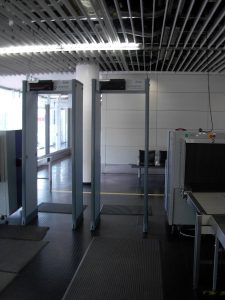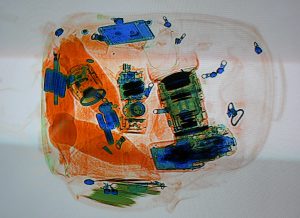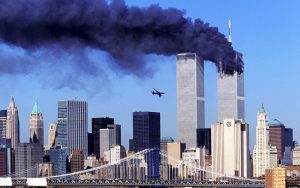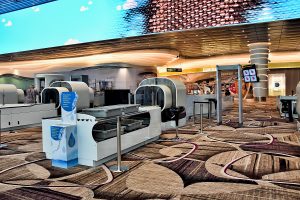26 Security Screening in Airports
Emily Kneller
26.1 Introduction
Keywords
- Computed Tomography (CT) systems: similar to what is used in the medical field; machine capable of producing 3D X-ray scans
- Explosive Detection Systems (EDS): a machine that can detect explosives hidden in checked baggage
- Magnetometers: another name for metal detectors; a technological device used to detect anything made of metal
- Millennials: the group of people born between the time period that roughly spans from 1981-1996
- Millimeter wave machines: screening technology that looks for hazardous objects on passengers through low-energy non-ionizing waves
- Transportation Security Administration (TSA): an agency part of the United States Department of Homeland Security that overlooks and regulates security in transportation systems
- 9/11: Al Queda-coordinated terrorist attacks on the U.S. through hijacked commercial airplanes that killed 2,996 people
Learning Objectives
By the end of this chapter, students should be able to:
- Recall the defining event initiating the boom in airport security technologies
- Differentiate between pre-9/11 and post-9/11 airport screening
- Explain the consequences on the millennial generation
- Identify the continued technological evolution up to present day

“Denver, CO: Airport, Security lines” by Diane Cordell is licensed under CC BY-NC-ND 2.0
“Okay… We need to get to the airport at 6:30 A.M. so we have an hour and a half to get through security before the flight at 8 A.M.” To the most recent generations, security checkpoints are a routine part of the travel experience. Security lines can range from ten minutes to an hour because of unpredictable airport busyness during your flight. As a result, individuals build in extra time before their departure to account for how long airport security may take that day.
If you lived through the terrorist attacks on the World Trade Center in 2001, this “routine” would not have always been normal. If you were young at the time of this event, you experienced the drastic changes in airport security shortly after and were forever changed by it. Therefore, millennials are most impacted by airport screening technologies. The terrorist attack on the World Trade Center in 2001 created the necessity for advanced technologies like passenger and baggage screening to increase airport security, which benefited the millennial generation but is accompanied by adverse consequences on the traveling experience.
26.2 What is Passenger and Baggage screening?
Key Takeaway
26.2.1 Passenger Screening

“Airport Security” by Piotrus is licensed under CC BY-SA 3.0
In airports worldwide, individuals walk through magnetometers, also known as metal detectors, to be scanned before being able to enter onto aircraft. Magnetometers uncover metal objects by creating a magnetic field through electric currents and low-energy non-ionizing radiation (EPA, 2022). The magnetic field will reflect to the detector if anything with metal is present on anything the individual walking through is wearing or attempting to hide. This sets off the machine and signals TSA officers watching individuals pass through with a beeping noise. Although, the detectors do not pick up small metal objects like delicate jewelry and jean buttons. Screening can also occur by millimeter wave machines that, similar to magnetometers, use low-energy non-ionizing waves to find any harmful materials passengers may be carrying (“What Can,” 2022).
26.2.2 Baggage Screening

“Xray-verkehrshaus” by User:IDuke is licensed under CC BY 2.5
Everything passengers attempt to bring with them onto the airplane must be checked separately through X-ray machines run by airport authorities. When you check a bag before going through the security checkpoints, your bags go through the same machinery as carry-on items to be examined for dangerous objects or weapons. The scanners produce images of what is inside passengers’ luggage to look for these items that could threaten other passengers or airplane personnel. The photos show the density of what is inside the bags, which helps authorities identify prohibited substances. Unlike magnetometers and millimeter wave machines, these technologies screen for metal and nonmetal-containing objects.
However, airport workers cannot always tell what specific items are from these pictures, so those bags are pulled aside and searched. In addition, security officers request passengers to take out “large electronic devices,” food, and any liquids under the specified limit to make the screening process easier and faster. Additionally, Explosive Detection Systems (EDS) scan checked bags for any explosive weapons passengers attempt to sneak across the conveyor. Any airport-prohibited items found are confiscated, and individuals will have to travel without them or turn around at the security checkpoint and miss out on their flight.
26.3 Impact of 9/11 on Airport Security Technologies
Key Takeaway
Multiple hijacking incidents occurred in the mid to late 1900s that necessitated the creation of technologies to decrease threats of dangerous objects and individuals boarding an aircraft. In July of 1970, the New Orleans, Louisiana airport introduced the first magnetometers in response to recent passenger hijacks. For example, in 1961, a passenger forced the pilot to reroute a Florida-directed airplane toward Cuba (Larson, 2010). These metal detectors would alert authorities nearby if it picked up metal, and further investigation, like a pat down, could be done. 3D X-ray machines for searching carry-on items accompanied when magnetometers were implemented in airports.
Despite these technological introductions, airport security was practically nonexistent for centuries. According to the Transportation Security Administration (TSA), airport personnel only screened checked bags 5% of the time (Blalock et al., 2007). Furthermore, airports hired their own personnel or contracted private security firms to monitor screening, but the Federal Aviation Administration was in charge of security policies in airports (Seidenstat, 2004). Airport rules required passengers to walk through a metal detector, but they did not have to place their jackets, belts, or shoes in bins to pass through separate screening. Friends and family would accompany their loved ones to the gate when security was this simple. The thought of this reality is unimaginable to the generations after the millennials.
The nature of airport security changed drastically after the terrorist attacks on September 11, 2001. On that day, extremists from the Al Queda group hijacked four airplanes. Two flew into the tallest World Trade Center (WTC) buildings, one flew into part of the Pentagon, and the other was overthrown by fellow passengers who crash-landed the plane into a field in Pennsylvania. The two planes that crashed into the WTC caused the towers to collapse, which injured and killed thousands. Nearly 3,000 died that day between all four impediments to American security. The catastrophic event, known as 9/11, struck fear in citizens across the United States and spurred the government to take initiatives to prevent something like that from ever happening again.

“The second plane is flying in the direction of the south tower – September 11, 2001” by manhhai is licensed under CC BY-NC 2.0
Congress and President George Bush immediately responded to enhance safety inside the United States aviation transportation system; establishing the Aviation and Transportation Security Act was their first effort. This piece of legislation demanded all checked bags be screened, moved the monitoring of passenger screening to federal agents, and created the TSA. In 2002, TSA was granted all authority over airport safety and security. A month after 9/11, a man named Richard Reid planted an explosive in a pair of shoes and tried igniting it on his flight (USA.gov, n.d.). EDS machines were implemented across all airports by the end of the following year in response to President Bush’s passed bill and the shoe bomb attempt.
26.4 Screening Effects on the Millennial Generation
Key Takeaway
26.4.1 Intended Consequence
Screening technologies were implemented across the United States to comfort the people who lived through or experienced the terrible events of 9/11. Checking passengers and bags was meant to prevent any restricted items or weapons from being carried onboard an airplane that someone could use to harm others. The bag is pulled aside and searched to provide an extra layer of security if anything alarming is seen. The transition of security management to the TSA positively affected the population as well. Results from a 2004 poll show that shifting security control to federal agents made 59% of passenger respondents feel more secure (Blalock et al., 2007).
In addition, September 11, 2001, altered the way passengers were viewed by airport and airline personnel. Not only was screening meant to ease other passengers’ safety concerns but to resolve staff’s worries regarding the threat individuals entering the airport may pose. Screening people before they are allowed onto the aircraft assures flight attendants that they are not holding illegal substances or carrying restricted items like the ones shown in the figure below.

“I thought this was a poster” by Joanna Poe is licensed under CC BY-SA 2.0
26.4.2 Unintended Consequences
The United States government did not prepare for millennial travelers’ reactions to the delays created by security checkpoint wait lines. United States citizens are increasingly valuing things that make life more convenient. Authors of The Journal of Law and Economics cite 2003 survey results that 63% of individuals questioned think security screening is becoming a greater nuisance (Blalock et al., 2007). Some objects that appear in images produced by the X-ray machines cannot be identified. As a result, bags must be pulled aside and physically searched. This, plus passengers not listening to instructions on what belongings must be taken out of their suitcase for screening, slows the entire security process down and creates long lines. In response, individuals preparing to travel must account for the unpredictability of security checkpoints so they do not miss their flight, which is incredibly irritating and stressful. Society positively views technologies that make our lives easier. If they do not meet our expectations, they are seen as unhelpful.
“The once common idea of leaving the airport during a multi-hour layover to tour a city seems foolhardy, given the uncertainty and anxiety of having to go through the gantlet again.” (Kujawinski, 2021)
Increasing baggage screening to a hundred percent came at a cost to American airports too. According to The University of Chicago Press journalists, screening employers jumped from about 16,000 to 56,000 a year after 9/11 (2007). To account for the additional costs, airlines removed complimentary food and drinks on the flight, increased ticket prices, put a price on checking bags, and more to cover employee compensation and technology costs. Passengers traveling by plane would now have to pay higher fees for a flight because of screening technology.
Interview with a Frequent Flyer
Let’s look at airport security views from the eyes of a millennial who flies frequently. Justin Ancona was born in 1995, meaning he was in kindergarten when the 9/11 attacks occurred. He doesn’t have much recollection of the event happening because he was so young. However, Justin attributes 9/11 as a significant factor in how he views security technologies.
Justin believes screening is beneficial to protect passengers despite its apparent inconvenience. He says that since he grew up with the technology from the beginning, he doesn’t see it as a problem and does not think much about whether traveling would be better without it. Furthermore, he has traveled to many places inside and outside the country throughout his life, suggesting his individual travel demand did not decrease after its implementation. Like many others, Justin would love to see improvements in the time taken to get through security. Still, he thinks safety is more important because it minimizes events like 9/11 from happening again.
Unlike Justin, from the case study’s experience, data suggests another unintentional byproduct of screening implementation. The University of Chicago studied whether passenger or baggage screening impacted the demand for aviation travel. They tested the two separately and at airports across the country that varied in size between 2002 and 2003. Their results concluded that passenger screening does not significantly affect travel demand, but baggage screening decreases demand. The data suggested bag screeners were responsible for a decrease of about 6% in travel demand overall. Specifically, it caused a 9% reduction in demand at large airports (Blalock et al., 2007). These passengers are willing to find other means of transportation because of the inconvenience of putting belongings through the machine. The government implemented the technologies to protect passengers and keep aviation travel demand the same, but the inconvenience caused by the devices shrunk demand.
26.5 Evolution of the Screeners
Key Takeaway
As a result of the unpredicted response to security checkpoint inefficiency, the Transportation Security Administration is constantly working to improve screening technologies. While protecting safety is a priority to all millennials changed by the series of events on 9/11, you can see from the case study that individuals wish for increased machine efficiency to speed the airport process up. American citizens want convenience in life, causing the need for technologies to solve our problems faster, better, and cheaper. Two significant developments in the safety routine have stuck out since the integration of screening machines in airports: TSA precheck and Computed Tomography (CT) systems.
26.5.1 Passenger Screening Developments
Individuals are assessed for threats they pose to aircraft before arriving at the airport by TSA PreCheck. Interested individuals fill out applications online and pay a fee to be registered. Once at the airport, TSA PreCheck passengers proceed through security in a separate line much quicker than the ordinary checkpoint lines. Not only do citizens part of the program get to “skip the lines,” but they do not have to remove certain items from their carry-on and body. Laptops can stay in the bag and belts, jackets, and shoes stay on for screening. This further speeds up the process for individuals and allows them to reserve less time for unpredictable security lines.
26.5.2 Bag Screening Advancements
Machines that detect explosives or deadly weapons and scan for illegal substances are continually updated to increase efficiency without violating safety standards. The purpose of upgrading screeners is to produce better images of objects inside the bag, so fewer physical searches must be done. The latest advancement in luggage screening, CT scans, create 3D instead of 2D X-ray images capable of showing bag items from all angles (USA.gov, n.d.). They are very similar to what medical professionals conduct advanced scans on patients. Since the machine can produce such clear scans, passengers may keep their laptops inside their bags. TSA hopes to continue enhancing this technology to minimize the number of items individuals need to take out of their bags and scan separately (USA.gov, n.d.).

“Changi Airport Terminal 4 (Open House)” by Choo Yut Shing is licensed under CC BY-NC-SA 2.0
Chapter Summary
When asked to think of specific technologies, at least at first, airport screeners probably do not come to mind. Despite being overlooked, the effect of their presence is seen by all who travel. Analyzing the origins and impacts of security technologies in airports is vital to understanding whether its implementation during millennials’ upbringing was beneficial or consequential. Although it has significantly improved airport safety, as seen above, other factors like travel demand and inconvenience should be considered.
It is imperative to examine airport screeners from the perspective of the millennial generation in the United States. Younger audiences, part of Gen Z and Gen Alpha, don’t have a picture of what airport procedures were like before the crackdown because they were not alive for the terrorist attacks on 9/11. Therefore, making conclusions about the effects and responses to screening technology based on their opinions alone is not helpful. While planning for and waiting in security lines can be annoying and stressful, we should realize this minor inconvenience is a small price to pay for having peace of mind that we can travel safely.
Review Questions
1. What generation demanded increased airport security and therefore was most impacted by it?
a) Baby Boomers
b) Millennials
c) Generation X
d) Generation Alpha
2. True or False: The first time airports employed metal was in the months following the 9/11 terrorist attack.
a) True
b) False
3. EDS machines were introduced to screen checked bags in airports as a result of an implanted and attempted to be ignited explosive. What object was the explosive hidden in?
a) A briefcase
b) A jacket
c) A water bottle
d) A shoe
4. Which is not one of the unintended consequences of airport screening from the reading?
a) Removing second items before walking through the magnetometers
b) Need to employ more TSA officials
c) Long security checkpoint lines
d) Lowers travel demand
5. Which of the following is NOT one of the ways screening technology has evolved since its increased prevalence following September 11, 2001?
a) TSA PreCheck
b) EDS machines
c) CT system machines
Answers:
-
- b 2. b 3. d 4. a 5. b
Food For Thought
- Gen Z and Gen Alpha did not experience 9/11 like the millennials did, which differentiates their views and opinions on airport security screening. In what ways does their response and placement of value on the technology differ? What do younger generations put a higher value on?
- TSA PreCheck allows passengers to keep items like their belt, jacket, and shoes on when walking through the metal detector if they fill out an application and pay the fee to be registered for the program. Do you think this corrupts the integrity of screening practices and treating all passengers fairly?
References
Baker, D. M. A. (2020). Tourism and terrorism: Terrorists’ threats to Commercial Aviation Safety and Security. Tourism, Terrorism and Security, 163–181. https://doi.org/10.1108/978-1-83867-905-720201012.
Blalock, G., Kadiyali, V., & Simon, D. H. (2007). The impact of Post‐9/11 Airport Security measures on the demand for Air Travel. The Journal of Law and Economics, 50(4), 731–755. https://doi.org/10.1086/5198.
EPA. (2022). Radiation and Airport Security Screening. EPA. Retrieved November 14, 2022, from https://www.epa.gov/radtown/radiation-and-airport-security-scanning.
Gerace, W. B. D. (2021, June 11). A look at how airport security has evolved Post 9-11. A Look at How Airport Security Has Evolved Post 9-11 | PHL.org. Retrieved November 9, 2022, from https://www.phl.org/newsroom/911-security-impact.
Josephs, L. (2021, September 11). How the Sept. 11 terrorist attacks Forever Changed Air Travel. CNBC. Retrieved November 9, 2022, from https://www.cnbc.com/2021/09/11/how-9/11-forever-changed-air-travel.html.
Kirschenbaum, A. (2013). The cost of airport security: The passenger dilemma. Journal of Air Transport Management, 30, 39–45. https://doi.org/10.1016/j.jairtraman.2013.05.002.
Kujawinski, P. (2021, September 9). Air travel after 9/11: Just get through it. The New York Times. Retrieved November 8, 2022, from https://www.nytimes.com/2021/09/09/travel/airline-travel-september-11.html.
Larson, G. (2010, September 1). Moments and milestones: Perfecting the People Filter. Smithsonian.com. Retrieved November 14, 2022, from https://www.smithsonianmag.com/air-space-magazine/moments-and-milestones-perfecting-the-people-filter-1490080/.
Seidenstat, P. (2004). Terrorism, airport security, and the private sector. Review of Policy Research, 21(3), 275–291. https://doi.org/10.1111/j.1541-1338.2004.00075.x.
USA.gov. (n.d.). Security screening. Security Screening | Transportation Security Administration. Retrieved November 9, 2022, from https://www.tsa.gov/travel/security-screening.
USA.gov. (n.d.). Transportation security timeline. Transportation Security Timeline | Transportation Security Administration. Retrieved November 16, 2022, from https://www.tsa.gov/timeline.
USA.gov. (n.d.). TSA precheck®. TSA PreCheck® | Transportation Security Administration. Retrieved November 18, 2022, from https://www.tsa.gov/news/press/factsheets/tsa-precheck.
Vermeulen, K. (2021). Generation disaster: Coming of age post-9/11. Oxford University Press.
What can airport scanners see in luggage? (checked bags vs. carry-on). EXECUTIVE FLYERS. (2022, July 28). Retrieved November 9, 2022, from https://executiveflyers.com/what-can-airport-scanners-see-in-luggage/.
the group of people born between the time period that roughly spans from 1981-1996
another name for metal detectors; a technological device used to detect anything made of metal
screening technology that looks for hazardous objects on passengers through low-energy non-ionizing waves
a machine that can detect explosives hidden in checked baggage
an agency part of the United States Department of Homeland Security that overlooks and regulates security in transportation systems
Al Queda-coordinated terrorist attacks on the U.S. through hijacked commercial airplanes that killed 2,996 people
similar to what is used in the medical field; machine capable of producing 3D X-ray scans

